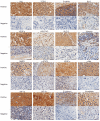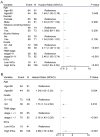Development and Validation of a Nomogram based on cell growth-related Biomarkers for Oral Squamous Cell Carcinoma
- PMID: 34335932
- PMCID: PMC8317514
- DOI: 10.7150/jca.54475
Development and Validation of a Nomogram based on cell growth-related Biomarkers for Oral Squamous Cell Carcinoma
Abstract
Purpose: We aimed to develop a prognostic nomogram based on immunohistochemistry (IHC) biomarkers of patients with oral squamous cell carcinoma (OSCC). Methods: A total of 294 patients were enrolled in the study. The least absolute shrinkage and selection operator (LASSO) Cox regression model was performed to develop a combined IHC score (IHCs) classifier. Results: Five biomarkers, specifically c-Met, Vimentin, HIF-2α, VEGF-c, and Bcl-2 were extracted. Then, an IHCs classifier was developed, and patients were stratified into high- and low-IHCs groups. In the training cohort, the 5-year overall survival (OS) was 62.1% in low-IHCs group and 28.2% in high-IHCs group (P<0.001). The 5-year OS was 68.6% for the low-IHCs group and 28.4% for the high-IHCs group in the validation cohort (P<0.001). The area under the ROC curve (AUROC) of the combination of the IHCs classifier and TNM stage was 0.746 (95% CI: 0.658-0.833) in the training cohort and 0.735 (95% CI: 0.651-0.818) in the validation cohort, respectively. Conclusions: The nomogram could effectively predict the prognosis for patients with OSCC and may be employed as a potential tool to guide the individual decision-making process.
Keywords: biomarkers; immunohistochemistry; nomogram; oral squamous cell carcinoma; prognosis.
© The author(s).
Conflict of interest statement
Competing Interests: The authors have declared that no competing interest exists.
Figures






Similar articles
-
Prognostic value of an immunohistochemical signature in patients with esophageal squamous cell carcinoma undergoing radical esophagectomy.Mol Oncol. 2018 Feb;12(2):196-207. doi: 10.1002/1878-0261.12158. Epub 2018 Jan 6. Mol Oncol. 2018. PMID: 29160958 Free PMC article.
-
A prognostic nomogram integrating novel biomarkers identified by machine learning for cervical squamous cell carcinoma.J Transl Med. 2020 Jun 5;18(1):223. doi: 10.1186/s12967-020-02387-9. J Transl Med. 2020. PMID: 32503630 Free PMC article.
-
An integrated nomogram combining lncRNAs classifier and clinicopathologic factors to predict the recurrence of head and neck squamous cell carcinoma.Sci Rep. 2019 Nov 25;9(1):17460. doi: 10.1038/s41598-019-53811-0. Sci Rep. 2019. PMID: 31767907 Free PMC article.
-
Prognostic Value of an Immunohistochemical Signature in Patients With Head and Neck Mucosal Melanoma.Front Immunol. 2021 Jul 29;12:708293. doi: 10.3389/fimmu.2021.708293. eCollection 2021. Front Immunol. 2021. PMID: 34394109 Free PMC article.
-
Prognostic Value of an Immunohistochemical Signature in Patients With Bladder Cancer Undergoing Radical Cystectomy.Front Oncol. 2021 Mar 25;11:641385. doi: 10.3389/fonc.2021.641385. eCollection 2021. Front Oncol. 2021. PMID: 33842349 Free PMC article.
Cited by
-
The Relationship between VEGF-C, TAM, and Lymph Node Metastasis in Oral Cancer.Evid Based Complement Alternat Med. 2022 Jun 28;2022:9910049. doi: 10.1155/2022/9910049. eCollection 2022. Evid Based Complement Alternat Med. 2022. Retraction in: Evid Based Complement Alternat Med. 2023 Dec 13;2023:9854016. doi: 10.1155/2023/9854016. PMID: 35800004 Free PMC article. Retracted.
References
-
- Torre LA, Bray F, Siegel RL, Ferlay J, Lortet-Tieulent J, Jemal A. Global cancer statistics, 2012. CA Cancer J Clin. 2015;65:87–108. - PubMed
-
- Huang JF, Wang JW, He BC, Chen F, Liu FP, Yan LJ. et al. [Study of survival factors of oral squamous cell carcinoma] Zhonghua Yu Fang Yi Xue Za Zhi. 2016;50:880–6. - PubMed
-
- Pruegsanusak K, Peeravut S, Leelamanit V, Sinkijcharoenchai W, Jongsatitpaiboon J, Phungrassami T. et al. Survival and prognostic factors of different sites of head and neck cancer: an analysis from Thailand. Asian Pac J Cancer Prev. 2012;13:885–90. - PubMed
-
- Zhong LP, Zhang CP, Ren GX, Guo W, William WN Jr, Sun J. et al. Randomized phase III trial of induction chemotherapy with docetaxel, cisplatin, and fluorouracil followed by surgery versus up-front surgery in locally advanced resectable oral squamous cell carcinoma. J Clin Oncol. 2013;31:744–51. - PMC - PubMed
LinkOut - more resources
Full Text Sources
Miscellaneous

